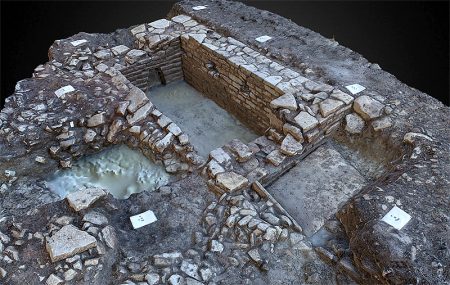Evidence of a Roman villa has recently been discovered at a site between Cheswick Village and Lockleaze, just within the Stoke Gifford parish boundary.
Archaeological fieldwork by Cotswold Archaeology was completed in March 2018 on land that was previously owned by Dings Crusaders Rugby Football Club and has now become a new housing development by Redrow Homes South West.
CgMs Heritage acted as archaeological consultants throughout the excavation.
Since the fieldwork was completed, archaeologists have been compiling what they discovered in order to understand what the villa may have looked like. While many of the villa’s walls and floor surfaces had been removed once the building fell into disuse, in some areas intact walls and floors survived, allowing Cotswold Archaeology to get a good understanding of the layout of the villa. Well-preserved features included the remains of hypocausts (a system of central heating where hot air is circulated below the floor of a room) and evidence for a courtyard or garden, as well as a series of outbuildings, external to the main courtyard and house.
The excavation has provided archaeologists with an insight into the development and organisation of Romano-British villa estates. It is believed that the site began during the Late Iron Age or Early Roman period as a sub-oval enclosure, which contained a roundhouse. This then developed during the 1st to 2nd centuries AD when fields, paddocks and trackways were laid out over part of the site, replacing the earlier enclosure.
Between the 2nd and late 3rd/early 4th centuries AD the site was then occupied by a timber structure, along with a rectangular stone-built building. This seems to have been a barn, providing evidence of industrial or agricultural processing. The settlement was completely remodelled in the later Roman period when a substantial residence, a walled courtyard and a range of ancillary buildings were built over the remains of the earlier buildings.
Along with the discovery of the villa buildings, the archaeological team also unearthed an inhumation burial (a burial in the ground) which probably dates to the late 2nd or 3rd century AD and a human cremation which was buried within a small pottery vessel. They also discovered dress accessories, coins and a rare bronze hanging lamp which has attracted the attention of numerous archaeology experts. It is believed that the lamp was manufactured in the 1st century AD and even though some parts are missing, it has been quite well preserved. The lamp appears to portray a figure wearing a tunic and sitting cross-legged. Several specialists have been approached to try to identify the figure with suggestions being made such as a Buddha, an Egyptian subject, the Roman satyr Silenus or a figure from everyday life reading a scroll under the light of the lamp.
To read more about the discoveries that have been made at the excavation site in Stoke Gifford, visit cotswoldarchaeology.co.uk, where you can find articles and 3D models of the villa.
More information and related links:
- Location map (The Journal)
- A newly discovered Roman villa at Stoke Gifford (Cotswold Archaeology)
- An unusual lamp from a recently discovered villa at Stoke Gifford (Cotswold Archaeology)
- 3D models of the Roman villa features (Sketchfab)
- Ancient Roman villa hidden under a Bristol rugby pitch for decades is BULLDOZED by developers without locals even getting to see it (Mail Online)
Photos: 1 3D-model of a stone-built sunken water tank discovered at the site [view in 3D]. 2 An unusual bronze hanging lamp discovered during the excavation.
This article originally appeared in the February 2019 issue of the Stoke Gifford Journal news magazine (on page 11). The magazine is delivered FREE, EVERY MONTH, to over 5,000 homes in Stoke Gifford, Little Stoke and Harry Stoke. Phone 01454 300 400 to enquire about advertising or leaflet insertion.





